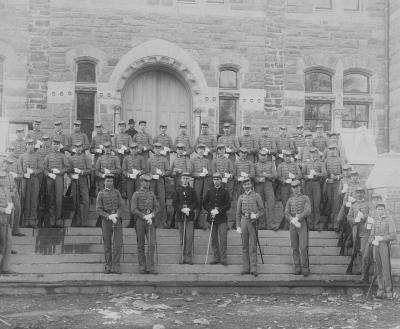The Georgetown University Army ROTC (Reserve Officers Training Corps) dates back to the University's founding. Since 1918, Georgetown has commissioned more than 4,100 officers, including a former Chief of Staff of the Army.
History of the Program
The Georgetown Cadets program was not officially established until 1836. However, the history of the program dates back to as early as George Washington's presidency, when he visited Georgetown to see his two nephews. President Washington complimented the men's uniform and discipline. In 1831, the College's young men, dressed in uniform, marched in formation from George Town to the White House, impressing President Andrew Jackson. In 1836, a group of Georgetown Students started calling themselves the College Cadets. One of the founders, Henry Heth, who was the valedictorian of the Class of 1837, took a commission in the Army as soon as he graduated and eventually became a Major General in the Confederate States Army during the Civil War. During the Civil War, out of the 358 Cadets who fought in the Civil War, 117 cadets were killed in battle.
It was only in October 5, 1852, that the Georgetown College Cadets became an official university organization. However, because the program was student-run, Georgetown students who wanted to become officers still had to matriculate to West Point or an Officer Candidate’s School at Fort Myer.
This all changed with World War I. ROTC was created by Congress in 1916, when US officials recognized that college students were a high-quality bank of potential soldiers in the war. ROTC programs began in universities across the United States and implemented standardized manuals for military drills to train future military leaders and officers. Courses such as "Military Law and Practice" and "War Issues" were added to Georgetown's curriculum. After these additions to the curricula, The Washington Post published an article titled "Georgetown Will Open As War School."
In 1918, at the height of the war, the War Department officially established an Infantry Unit Senior Division ROTC Georgetown, and issued a statement of suggestions regarding Georgetown's curricula of war training at Georgetown.
On April 13, 1952, Georgetown signed an agreement with the Department of Defense to establish a military government unit on campus. This selection was because of Georgetown's unique facilities, including the hospital, and the School of Foreign Service's expertise in security and international law. The GU Unit was the only military government unit in the U.S. that partnered with a private institution.
In 1964, Congress passed the ROTC Vitalization Act, which developed the program and added additional scholarships for students. Both these programs in conjunction led to more cadets joining the ROTC to alleviate the financial costs of attending university. To cut operating costs, the District's colleges founded the Consortium of Universities of the Washington Metropolitan Area, which allowed other schools to enroll in Army ROTC at Georgetown. The Hoya Battalion to this day welcomes cadets from American University, The Catholic University of America, George Washington University, Marymount University, and the University of Maryland.
In Fall, 1972, the Hoya Battalion admitted their first class of women. During this decade, 20 percent of cadets were women. Lizanne Siccardi, one of the female cadets said, "Most people tell me it's crazy or it's great I'm in ROTC. Some have called me a killer."1
Controversies
In 1969, at the height of the Vietnam War, the ROTC issue began to divide Georgetown’s campus. Fifty students occupied ROTC offices in Old North for a three-hour-long sit-in. On the other side, sympathetic students and proponents of the ROTC created the Committee to Defend ROTC. A student referendum showed that 68% of the students supported ROTC on campus. Students and faculty have argued that the ROTC is important for student scholarships. They argue that if war is inevitable, it is important for Georgetown to train smart and ethical officers for the future. During this period, student newspapers voiced their opposition to the program. The Hoya expressed opposition, stating that ROTC serves no function in an academic institution and violates neutrality.
Opponents of the ROTC have continued to argue that a military organization in a Jesuit institution is contradictory. They argue that the ROTC is against the University's values of peace and justice. Richard McSorley, S.J., a renowned peace activist, said that the ROTC "diverts the university from the academic goal of seeking truth and teaching the truth.2 The military is an intruder into the fields of academia with a different arm and a different method." In 1968, students opposing the war in Vietnam hired a plane to spray leaflets to model the US's chemical warfare in Vietnam. In one instance, Major Richard D. Ranc had to cancel his Military Science class because protestors occupied his classroom, one of whom was Professor James Greene of Georgetown's Philosophy Department.3
In 1973, after a subcommittee in the SFS considered making ROTC a sub-department, McSorley and Jerry Hall led a hunger strike and prayer vigil in opposition. During the antiwar protests, ROTC students were unable to take programs for academic credit. This was restored in 1974, when a selected number of ROTC courses were eligible for academic credit.
Since its controversies during the height of anti-war sentiment, Georgetown ROTC has not faced major threats and has consistently placed among the top 100 Army ROTC units in the country.



